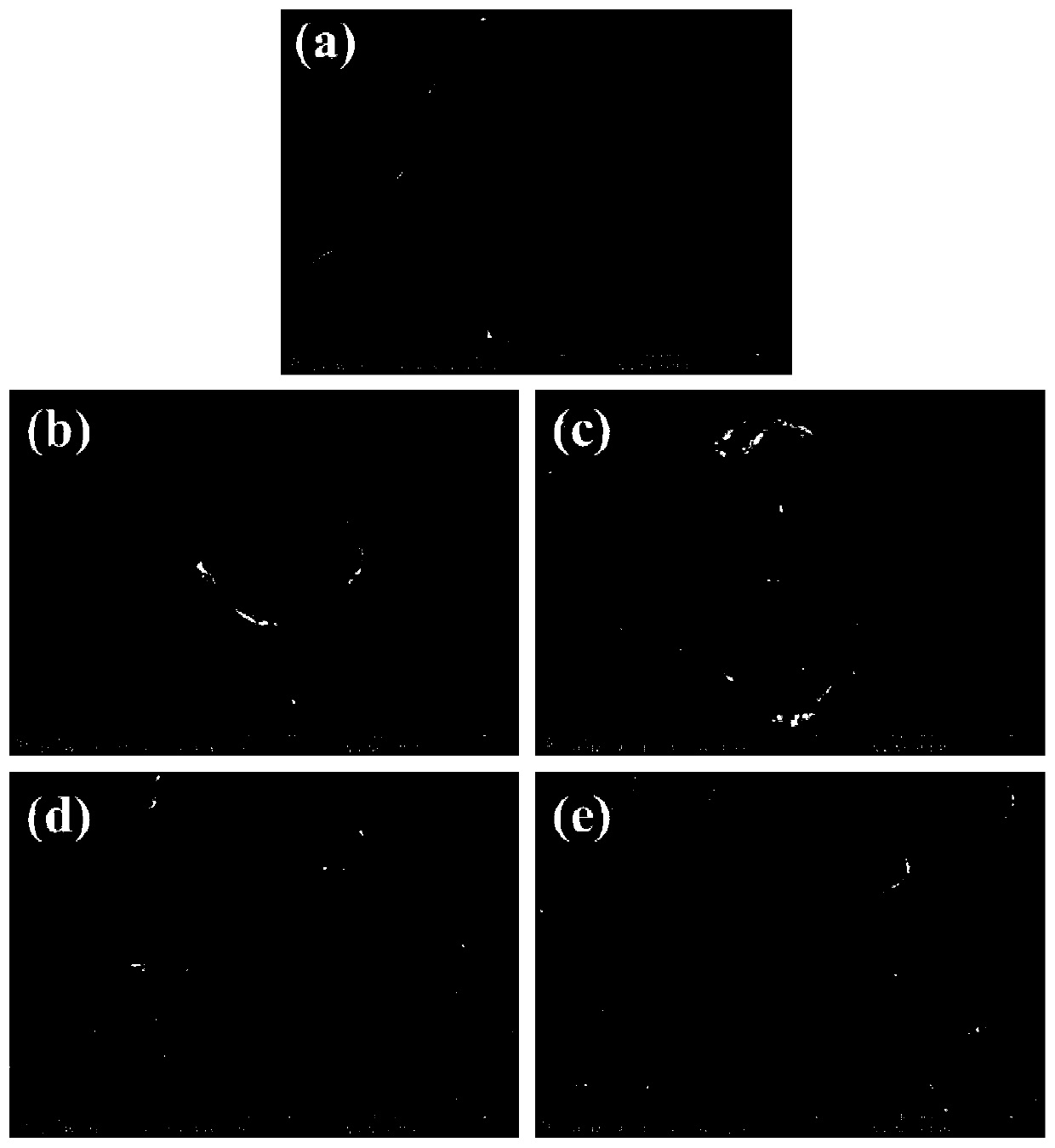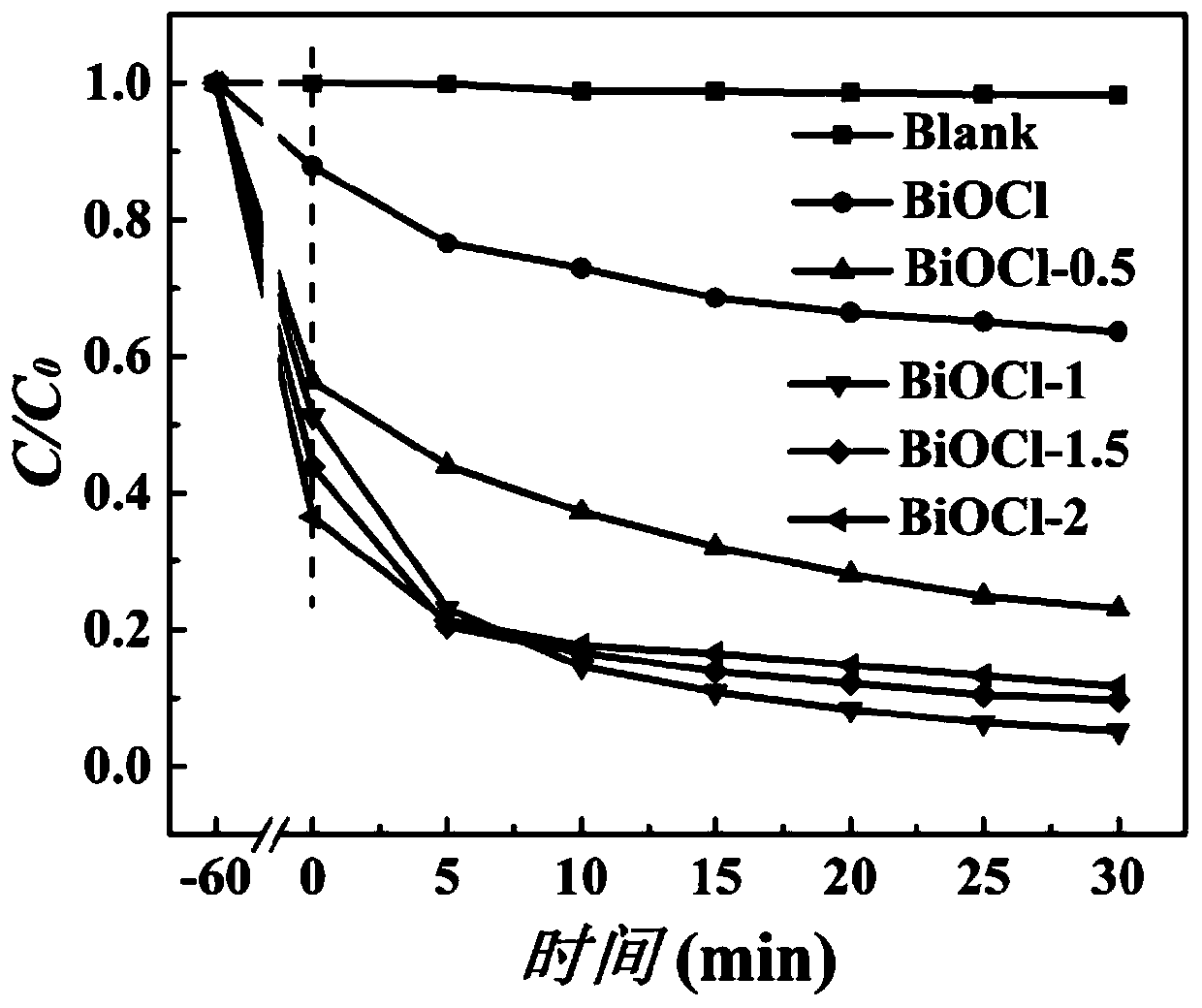Method for preparing BiOCl with adjustable thickness at room temperature
- Summary
- Abstract
- Description
- Claims
- Application Information
AI Technical Summary
Problems solved by technology
Method used
Image
Examples
Embodiment 1
[0030] 1) Preparation of BiOCl monomer
[0031] First, 0.97 g of Bi(NO 3 ) 3 ·5H 2 O was added to 60 mL of aqueous solution and stirred for another 20 minutes. Then 10 mL of 1 mol / L hydrochloric acid solution was added. After stirring for 30 minutes, the precipitate was collected, washed repeatedly with ultrapure water and ethanol, and dried at 60°C to obtain BiOCl nanosheets, which were used for subsequent blank experiments.
[0032] 2) Preparation of BiCOl photocatalyst with adjustable thickness
[0033] Disperse 0.5, 1, 1.5, 2g (molar ratio 1:50-300) of mannitol respectively in 60mL of ultrapure water, stir well to dissolve, then add 0.97g of Bi(NO 3 ) 3 ·5H 2 O was added therein respectively, and after stirring for 20 minutes, 10 mL of 1 mol / L hydrochloric acid solution was added respectively. After stirring for 30 minutes, the obtained precipitate was centrifuged, washed repeatedly with ultrapure water and ethanol, and dried at 80°C to obtain BiOCl- 0.5, BiOCl-1, ...
Embodiment 2
[0038] 1) Preparation of BiOCl monomer
[0039] First, 0.97 g of Bi(NO 3 ) 3 ·5H 2 O was added to 60 mL of aqueous solution and stirred for another 20 minutes. Then 10 mL of 1 mol / L sodium chloride solution will be added. After stirring for 30 minutes, the precipitate was collected, washed repeatedly with ultrapure water and ethanol, and dried at 60°C to obtain BiOCl nanosheets, which were used for subsequent blank experiments.
[0040] 2) Preparation of BiCOl photocatalyst with adjustable thickness
[0041] Disperse 0.5, 1, 1.5, and 2 g of mannitol in 60 mL of ultrapure water, and stir to dissolve them, then add 0.97 g of Bi(NO 3 ) 3 ·5H 2 O was added therein respectively, after stirring for 20 minutes, 10 mL of 1 mol / L sodium chloride solution was added respectively, after stirring for 30 minutes, the precipitate obtained was centrifuged, washed repeatedly with ultrapure water and ethanol, and dried at 80°C to obtain BiOCl-0.5, BiOCl-1, BiOCl-1.5, BiOCl-2 nanosheets....
Embodiment 3
[0043] 1) Preparation of BiOCl monomer
[0044] First, 0.97 g of Bi(NO 3 ) 3 ·5H 2 O was added to 60 mL of aqueous solution and stirred for another 20 minutes. Then 10 mL of 1 mol / L potassium chloride solution will be added. After stirring for 30 minutes, the precipitate was collected, washed repeatedly with ultrapure water and ethanol, and dried at 60°C to obtain BiOCl nanosheets, which were used for subsequent blank experiments.
[0045] 2) Preparation of BiCOl photocatalyst with adjustable thickness
[0046] Disperse 0.5, 1, 1.5, and 2 g of mannitol in 60 mL of ultrapure water, and stir to dissolve them, then add 0.97 g of Bi(NO 3 ) 3 ·5H 2 O was added therein respectively, after stirring for 20 minutes, 10 mL of 1 mol / L potassium chloride solution was added respectively, after stirring for 30 minutes, the obtained precipitate was centrifuged, washed repeatedly with ultrapure water and ethanol, and dried at 80°C to obtain BiOCl-0.5, BiOCl-1, BiOCl-1.5, BiOCl-2 nanos...
PUM
 Login to View More
Login to View More Abstract
Description
Claims
Application Information
 Login to View More
Login to View More - R&D
- Intellectual Property
- Life Sciences
- Materials
- Tech Scout
- Unparalleled Data Quality
- Higher Quality Content
- 60% Fewer Hallucinations
Browse by: Latest US Patents, China's latest patents, Technical Efficacy Thesaurus, Application Domain, Technology Topic, Popular Technical Reports.
© 2025 PatSnap. All rights reserved.Legal|Privacy policy|Modern Slavery Act Transparency Statement|Sitemap|About US| Contact US: help@patsnap.com



